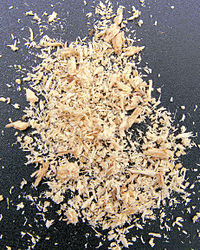
Photo from wikipedia
The use of residual biomass for bioconversions makes it possible to decrease the output of fossil-based chemicals and pursue a greener economy. While the use of lignocellulosic material as sustainable… Click to show full abstract
The use of residual biomass for bioconversions makes it possible to decrease the output of fossil-based chemicals and pursue a greener economy. While the use of lignocellulosic material as sustainable feedstock has been tried at pilot scale, industrial production is not yet economically feasible, requiring further technology and feedstock optimization. The aim of this study was to examine the feasibility of replacing woodchips with residual sawdust in biorefinery applications. Woodchips can be used in value-added processes such as paper pulp production, whereas sawdust is currently used mainly for combustion. The main advantages of sawdust are its large supply and a particle size sufficiently small for the pretreatment process. Whereas, the main challenge is the higher complexity of the lignocellulosic biomass, as it can contain small amounts of bark and cambium. Here, we studied the fractionation of birch sawdust by organosolv pretreatment at two different temperatures and for two different durations. We evaluated the efficiency of fractionation into the three main fractions: lignin, cellulose, and hemicellulose. The cellulose content in pretreated biomass was as high as 69.2%, which was nearly double the amount in untreated biomass. The obtained lignin was of high purity, with a maximum 4.5% of contaminating sugars. Subsequent evaluation of the susceptibility of pretreated solids to enzymatic saccharification revealed glucose yields ranging from 75% to 90% after 48 h but reaching 100.0% under the best conditions. In summary, birch sawdust can be successfully utilized as a feedstock for organosolv fractionation and replace woodchips to simplify and lower the costs of biorefinery processes.
Journal Title: Molecules
Year Published: 2021
Link to full text (if available)
Share on Social Media: Sign Up to like & get
recommendations!